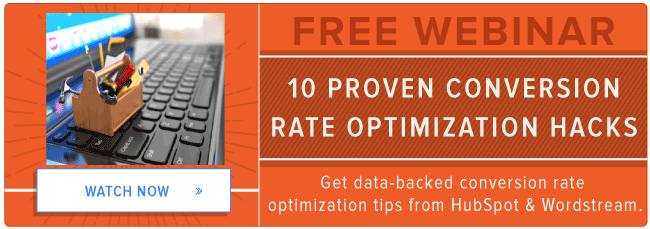The Biggest Pet Peeves of CRO Experts

Conversion Rate Optimization (CRO) isn't a widely known field, even among digital marketers. If you need a quick refresher, CRO is the process of creating an experience for your website visitors that'll convert them into customers.
But this science of lead conversion is quickly gaining ground. After all, who doesn’t want more clicks, leads, and sales?
On International Conversion Rate Optimization Day back in April, some of the best CRO experts in the business came together for an "Ask Me Anything" discussion on inbound.org, where they answered questions about all things conversion rate optimization. One of the interesting topics they covered was the things that really tick them off in the world of CRO. And trust me when I say they didn't hold back.
What were some of the things that grinded these CRO experts' gears? Here are 13 pet peeves related to conversion rate optimization to be sure you aren't making on your website.
13 Pet Peeves From CRO Experts
1) Over-Simplification
The world is not simple, yet it’s natural for people to oversimplify everything. Optimizers have to be better than that. There is no 'people always prefer' or 'who would ever.'"
– Peep Laja (author, CRO specialist, & founder of ConversionXL)
(Read more from Laja here.)
2) Assumptions
You should [make it] very easy for the user to checkout. The buttons and headlines should tell people what to do next. Never make assumptions that you know what the customer should do."
– Alex Harris (e-commerce conversion specialist)
(Read more from Harris here.)
... Send good cart abandonment emails (and A/B test them), minimize distractions during the checkout process, make it clear to the customer what's happening in the process and when, try to avoid anything that makes it look like you're springing surprise fees or clever accounting on the customer, and reinforce why they're buying from you (painless pre-paid returns process, best in class quality, social proof of satisfied customers, etc. etc. -- test what works best for your customers)."
– Jim Gray (marketing engineer, data scientist & founder of Ioseed)
(Read more from Gray here.)
3) “Click Here” on Calls-to-Action
I personally hate "click here" prefixes, and so do search engines. (It hurts SEO.) It begs the question, does your CTA not already look like a clickable button For both headlines and CTAs, I use a variation of the fore mentioned formula: "I'd like to..." [WHAT: Specific Action]; "Because I want to..." [WHY: Specific Value].
"It's important to pair WHAT and WHY together. Sometimes this can be accomplished in one line. Two lines (headline + subhead, 2-line CTA, CTA + booster) are more often needed though. This shouldn't be feared if it provides more clarity and value."
– Angie Schottmuller (chief of conversion marketing at Unbounce)
(Read more from Schottmuller here.)
A simple formula to follow for button CTA's is 'Action Verb' + 'Benefit.'"
– Bobby Hewitt (president and founder of Creative Thirst)
(Read more from Hewitt here.)
4) Ghost Buttons
Ghost buttons drive me crazy. It goes against usability. The concept is a designer's fantasy trend that should die. The only time I find this tactic useful is when a client insists in having two CTAs on the page, and I basically want one to disappear. Ghosted buttons have ghost conversions."
– Angie Schottmuller (chief of conversion marketing at Unbounce)
(Read more from Schottmuller here.)
5) Ego
"It can be really hard to let something go when you've sweated over it. If it loses, you have to have the courage to throw it away. The best way to do that is to celebrate the fact that you learned something from the failure."
– Oli Gardner (co-founder of Unbounce)
(Read more from Gardner here.)
6) Unclear Call-to-Action Copy
It has to be abundantly clear what's going to happen when someone clicks that button. What are they going to get? Are they scheduling a demo, or signing up for that demo right then and there? You can't afford to leave people wondering, or they won't click out of nervousness."
– Joel Klettke (CRO copywriter)
(Read more from Klettke here.)
7) A "One-Size-Fits-All" Approach
I've seen case studies where including the word click increased... clicks. But like every case study, it isn't a panacea and should be taken with a grain of salt. You can't apply case study learnings, only use them to serve as inspiration and to be used to generate your own related hypothesis."
– Oli Gardner (co-founder of Unbounce)
(Read more from Gardner here.)
Everything you've read about button design is true, and false, and somewhere in between. If you truly believe that the best hypothesis and test you can come up with -- the one that will deliver a 200% increase on conversions -- is to change the button, then you should run A/B or multivariate tests against all of those options to see what works for your audience.
"The fact is, different audiences relate to different designs, language, reading levels, colors, and more. Averages across industries won't help you here."
– Stewart Rogers (director of marketing technology at VentureBeat Insight)
(Read more from Rogers here.)
8) Superlatives and Hyperboles
When it comes to using words like “amazing,” Peep Laja said it best: “Superlatives tend to lose against specifics (‘amazing pizza’ vs ‘stone-oven baked pizza by an Italian master chef,’ ‘fastest pizza delivery’ vs ‘delivery in 15 minutes’) 9 times out of 10. Instead of superlatives, offer lots of detail and specifics.”
Superlatives tend to lose against specifics ('amazing pizza' vs. 'stone-oven baked pizza by an Italian master chef;' 'fastest pizza delivery' vs. 'delivery in 15 minutes') 9 times out of 10. Instead of superlatives, offer lots of detail and specifics."
– Peep Laja (author, CRO specialist, & founder of ConversionXL)
(Read more from Laja here.)
Instead of obsessing over individual words, think about your context and slash hyperbole wherever it stands. If the claims you are making are believable, hit on customer pain points and directly explain a benefit, then the verbiage you use to describe that benefit can be flexible, so long as it fits the context."
– Joel Klettke (CRO copywriter)
(Read more from Klettke here.)
9) Buzzwords
i personally loathe 'rockstar.' I've used it. I'm embarrassed about it. But ... when I see it on a page today, I instantly get that feeling that an old person is trying to sound young."
– Joanna Wiebe (conversion copywriter)
(Read more from Wiebe here.)
10) Fluffy Language
A big hindrance on conversion rates and SEO alike is content that reads like generic fluff for the sake of targeting phrases."
– Joel Klettke (CRO copywriter)
(Read more from Klettke here.)
11) Half-Baked Value Props
I hate when writers rely on old, tired [stuff] like, 'We do X so that you can focus on what matters!'(...so.. what matters?); 'We get to know our customers' (everyone does); 'We're the highest quality' (what does that even MEAN? Nobody wants high quality!)."
– Joel Klettke (CRO copywriter)
(Read more from Klettke here.)
12) Ignoring or Avoiding Data
In answering the question, "What's your biggest pet peeve?"
When others pretend like the data doesn't exist."
– Tommy Walker (marketer at Shopify)
"Or worse, when others attempt to manipulate math for statistical significance to claim that the data qualifies as a valid test. Statistical significance is not the same as validity."
– Angie Schottmuller (chief of conversion marketing at Unbounce)
(Read more from Walker and Schottmuller here.)
13) Businesses That Stop Testing
“Always be testing” was the rallying cry for this crowd. The takeaway? Keep on testing, even after you have wins. (If you're not sure where to start, here's a list of real-life CRO tests to try for yourself.)
Many thanks to all the CRO specialists who joined me in this inbound.org discussion.
What are your biggest CRO pet peeves? Share them with us in the comments.


0 Comments:
Post a Comment
Subscribe to Post Comments [Atom]
<< Home